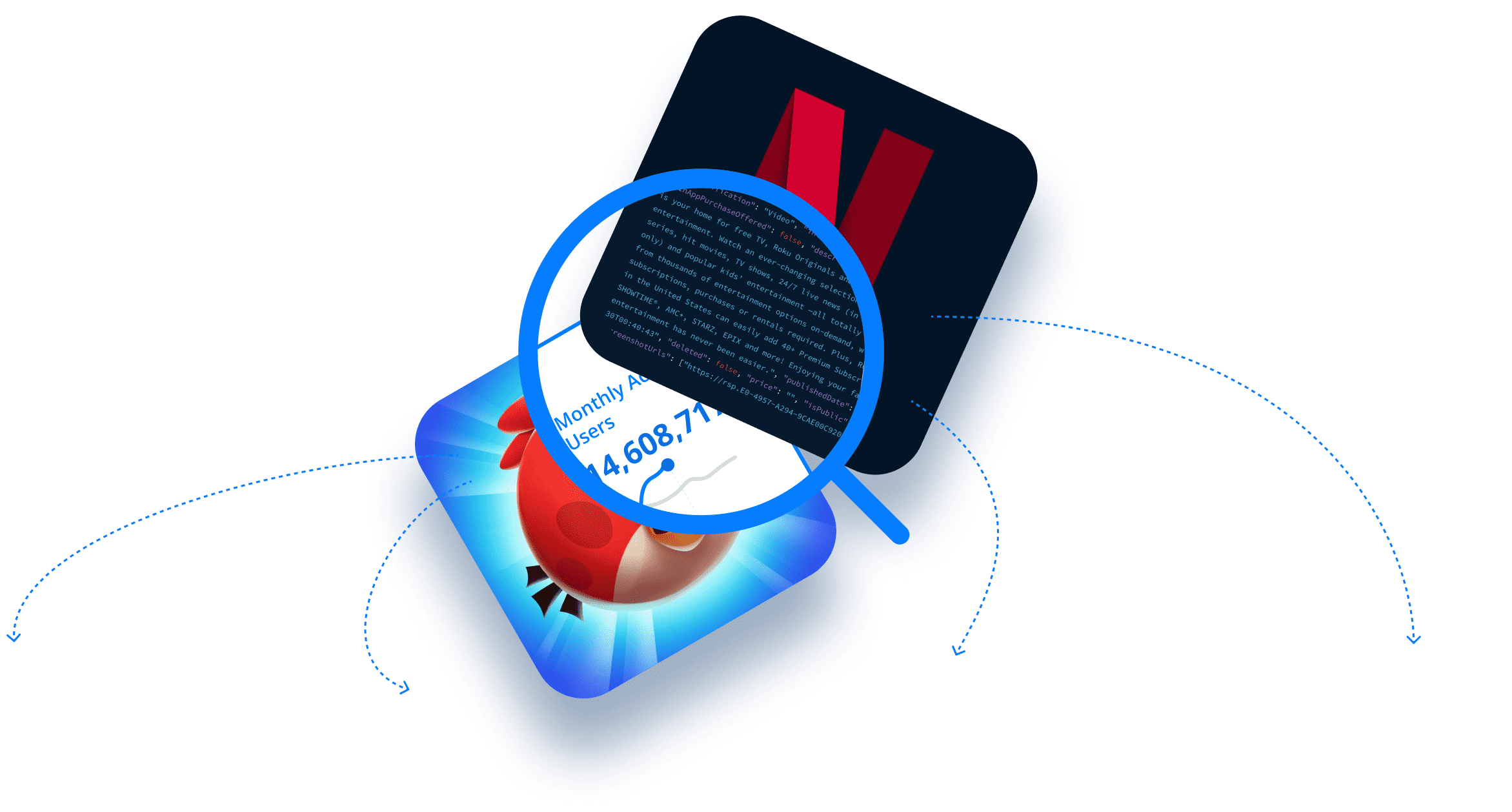In this article, we discuss how app metadata can be used to enhance your mobile app security posture. We quickly define app metadata, explain how leading cyber security companies use app metadata for mobile app security, and then show how 42matters’ app intelligence solutions can be used to access metadata for millions of apps across 12 leading app stores. With that, let’s get down to business!
Here’s what we cover in this blog post (click the links to jump to the corresponding section):
- What Is App Metadata?
- Examples of App Metadata
- How App Metadata Is Used for Mobile App Security
- How App Metadata Can Be Used for Mobile App Security
- Real-World App Metadata Use Cases for Mobile App Security
- How to Access App Metadata
To learn how to access app metadata for mobile app security and other cyber security use cases, chat with our team!
What Is App Metadata?
App metadata refers to the data elements (e.g. title, subtitle, screenshots, etc.) that provide essential information regarding an app’s content, functionality, and requirements. Typically provided by app publishers and displayed on app store listings, metadata is not part of the actual content of the app but provides crucial information about the app.
Moreover, while there’s a lot of overlap, metadata varies slightly from app store to app store. For example, while Android apps on Google Play have metadata elements like Short Descriptions, App Store Categories, and Age Ratings, iOS apps on the Apple App Store have Subtitles, App Store Genres, and Advisories. These serve more or less the same functions, but there are minor differences that may be relevant to consider depending on your specific metadata use case (i.e. mobile application security, mobile application management, mobile device management, etc.).
It’s also important to consider how metadata is impacted by localization. Localization is the process of adapting an app to meet the language, cultural, and other requirements of a target market or audience. The obvious examples are content-heavy elements like Titles, Short Descriptions, and Subtitles, which may be written in different languages or place emphasis on different app elements based on user language preferences or where users are accessing app stores from. However, another more interesting example is app content ratings. While Google Play has a native rating system based on the International Age Rating Coalition’s (IARC) methodology, they also leverage global standards from Pan-European Game Information (PEGI), Unterhaltungssoftware Selbstkontrolle (USK), Entertainment Software Rating Board (ESRB), Australian Classification Board (ACB), Classificação Indicativa (ClassInd), Game Rating and Administration Committee (GRAC), and others. This enables app publishers to tailor content ratings according to local sensitivities.
Need programmatic access to mobile and connected TV (CTV) app metadata? Try 42matters’ APIs free for 14-days!
Examples of App Metadata
Metadata is essential for app stores and platforms to effectively organize, display, and recommend apps to users. It also helps users make informed decisions about downloading and using apps, and can be used by businesses for things like mobile app security, digital advertising, lead generation, and more.
Key app metadata elements include:
- App Name and Description: The title of the app and a detailed description of its purpose, features, and functionalities.
- Screenshots and Preview Videos: Visual elements that showcase the app's interface and features, helping users understand what the app looks like and how it operates.
- Version Information: Data regarding the current version of the app, including version number and release notes detailing updates or changes.
- Publisher Details: Details about the app publisher, including name, country of origin, contact information, website, etc.
- App Category or Genre: Classification data that help categorize the app within an app store, aiding users in finding the app through search or browsing.
- Platform Availability: Information on which operating systems (like iOS, Android, Roku, etc.) and device types (smartphones, tablets, etc.) the app is compatible with, including specific version requirements.
- Required Permissions and Device Capabilities: A list of permissions and device capabilities the app requires to function, such as access to the camera, contacts, location, etc.
- Age Ratings and Content Advisories: Information on the appropriate age group for the app, based on its content and intended audience.
- Privacy Policy and Terms of Service: Links or details about the app's privacy policy and terms of service, outlining how user data is handled and the legal agreements between the user and the app publisher.
- Pricing and In-App Purchases: Details about the cost of the app, if any, and information on available in-app purchases.
- Supported Languages and Countries: Information about the different languages the app supports and the countries where it’s available.
- Ratings and Reviews: User-generated ratings and reviews, which can be considered as a form of dynamic metadata reflecting user experiences and opinions.
How App Metadata Is Used for Mobile App Security
Alright, now that we’ve covered the basics, let’s shift to the topic at hand: how app metadata can be used to enhance your mobile app security posture. By providing crucial information about key apps, their environments, and their usage, metadata enables organizations to identify, prevent, and respond to security threats. Use cases for app metadata encompass a wide range of activities, from identifying and mitigating security threats to enhancing user privacy and compliance.
We’ve split this section into two parts. The first describes in general terms how app metadata can be used for mobile app security. The second looks at some real-world use cases drawn from our own customers. Let’s begin by looking at…
How App Metadata Can Be Used for Mobile App Security
Here’s a quick overview of the section:
- Version Control and Updates
- Compatibility and Environment Checks
- Detecting Anomalous Behavior
- Security Policy Compliance
- Encryption and Data Security
- Digital Signatures and Integrity Checks
- Threat Intelligence Integration
- User Education and Awareness
Version Control and Updates
Metadata about an app's version can be used to ensure that users are running the most recent and secure versions of an app. It can also be used to trigger alerts for mandatory updates when critical security patches are released.
Compatibility and Environment Checks
Metadata also includes information about compatible operating system versions and hardware requirements. This can be used to ensure that apps operate in a secure and supported environment, reducing the risk of vulnerabilities that arise from outdated systems.
Detecting Anomalous Behavior
Some metadata elements, like update frequency, SDK integrations, required capabilities, and data protection practices, can help in identifying anomalous behavior that might indicate malicious activity or carelessness on the part of app publishers.
Security Policy Compliance
As alluded to above, metadata can include information about an app’s compliance with various security standards and global privacy regulations (GDPR, COPPA, CCPA, etc.). This helps in ensuring that apps adhere to the required security protocols and data protection laws.
Encryption and Data Security
Metadata about the types of data an app handles can guide the implementation of appropriate encryption and data protection measures. For example, Apple’s App Privacy Details and App Tracking Transparency (ATT) standards require publishers to provide information about their app’s privacy features in App Store Connect. This includes information about the practices of third-party partners whose code they integrate into their products. As such, these standards are useful for enterprise IT managers that make critical whitelisting and blacklisting decisions.
Digital Signatures and Integrity Checks
Metadata elements like digital signatures and checksums can be used to verify that apps and their updates have not been tampered with, ensuring the integrity of the app.
Threat Intelligence Integration
By analyzing app metadata in conjunction with broader threat intelligence data, developers and security teams can gain insights into emerging threats and vulnerabilities, allowing for proactive security measures.
User Education and Awareness
Metadata can be used to provide users with information about the security features of an app, promoting better awareness and responsible usage.
Start enhancing mobile app security with app metadata! Try 42matters’ APIs free for 14-days!
Real-World App Metadata Use Cases for Mobile App Security
Next up, let’s look at some examples of how companies use the metadata insights we provide at 42matters to improve their mobile app security posture and services.
Here’s an overview of the real-world examples we borrowed from our customers:
- Identification of Malicious Actors and Apps
- Historical and Trend Analysis
- Malware and Security Threat Detection
- App Integrity Verification
- Brand Protection and Impersonation Detection
- Fraud and Anomaly Detection
- Enhanced User Privacy and Data Security
- Monitoring App Lifecycle and Removals
- Enhancing Cybersecurity Products and Services
Identification of Malicious Actors and Apps
Many companies that we work with use app metadata to identify bad actors and apps that violate app store terms and conditions. Metadata insights can help companies uncover patterns indicative of malicious intent, such as irregular update histories, half-baked privacy policies, suspicious SDK integrations, sensitive permissions, unnecessary device capabilities, and more.
Historical and Trend Analysis
Metadata isn’t static. By analyzing historical trends and monitoring sudden changes to app behavior, security-minded organizations are able to make informed decisions regarding their defense posture. The companies we support tend to pay most attention to app publication histories, release notes and schedules, tech stack changes, user sentiment, etc.
Malware and Security Threat Detection
Some companies also use our solutions to analyze metadata elements like signing certificates and hashes to establish app publisher identity, ensure that apps have not been altered or tampered with after they have been signed, and monitor the integrity of app data and files. Likewise, they look at app permissions, SDKs, and version histories to uncover potential malware, vulnerabilities, or malicious software components.
App Integrity Verification
Along the same lines, companies use package names and APK files to verify the authenticity of apps, comparing them to official versions to ensure integrity and security. This helps them avoid installing apps that impersonate or spoof legitimate ones.
Brand Protection and Impersonation Detection
In addition, some companies use app metadata for brand protection, which is crucial for maintaining trust and security. For example, similar to the previous example, some of our B2B customers use metadata to detect newly released apps that may be impersonating their clients' apps.
Fraud and Anomaly Detection
Metadata analysis is also useful for revealing activities and anomalies, such as suspicious SDKs or changes in app certificates. In addition, a common technique for fraud detection is rating and review analysis, which helps organizations understand user sentiment. Many tools, including those we offer at 42matters, can even be used to automate the review analysis process and detect sudden changes to user sentiment.
Enhanced User Privacy and Data Security
Organizations also enhance user privacy and data security by ensuring that apps comply with data protection laws. For this, privacy policies and permissions are extremely helpful.
Monitoring App Lifecycle and Removals
Many companies also track unpublished or removed apps, which can be essential for understanding the lifecycle of apps and identifying potential security risks associated with discontinued applications.
Enriching Cybersecurity Products and Services
App metadata can also be used to enrich existing security solutions and security analytics platforms with publicly available app store data. For instance some of our customers use our solutions to bulk up their detection services for clients.
How to Access App Metadata
If you’d like to replicate any of the metadata-driven mobile app security use cases that we outlined above, you’ll need access to near real-time app intelligence. This is where 42matters comes into the picture.
We offer comprehensive insight into metadata for 20+ million apps across 12 leading mobile and connected TV (CTV) app stores. This includes Google Play, the Apple App Store, Amazon Appstore, Tencent Appstore, Huawei AppGallery, Roku Channel Store, Apple TV, Fire TV, Google TV, Samsung, Vizio, and LG.
While a number of our solutions can be used for metadata intelligence — including the 42matters Explorer, our flagship app market research platform — we’d like to introduce you to three of our most popular APIs and File Dumps. These solutions provide programmatic access to the app metadata insights necessary to support a variety of mobile app security and other cyber security-related use cases (e.g. mobile application management, mobile device management, etc.).
Specifically, our Mobile Security Data Sets, App Details File Dump, and Lookup API:
- Mobile Security Data Sets: Use these to analyze APK/IPA Resources and File Structures, see which SDKs apps use, check Android app Signing Certificate Hashes (SHA-1, SHA-256, and MD5), check Android APK File Hashes (SHA-1, SHA-256, and MD5), analyze Android Static URLs, and check sensitive app permissions.
- Available for: Google Play and Apple App Store
- Lookup API: Use this API to programmatically view app metadata for specified mobile apps, including Title, Subtitle, Description, Recent Updates, Screenshots, Price, Permissions, Supported Languages, Supported Countries, and more.
- Available for: Google Play, Apple App Store, Amazon Appstore, and Tencent Appstore.
- App Details File Dump: Use this File Dump to download comprehensive mobile and connected TV app metadata.
- Available for: Google Play, Apple App Store, Amazon Appstore, Tencent Appstore, Huawei AppGallery, Roku Channel Store, Google TV, Apple TV tvOS App Store, Amazon Fire TV, Samsung Smart TV, LG Content Store, and Vizio SmartCast.
Learn how our APIs and File Dumps can be used for mobile app security! Chat with our team.



